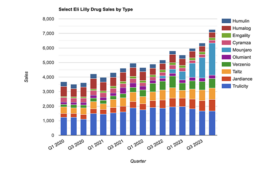
Indivior PLC announced the presentation of results from its pivotal Phase 3 clinical trial (RB-US-13-0001) evaluating the efficacy and safety of RBP-6000, an investigational once-monthly injectable buprenorphine in the ATRIGEL delivery system for the treatment of adults with moderate-to-severe opioid use disorder (OUD) as part of a complete treatment plan to include counseling and psychosocial support.
The 24-week study met its primary and key secondary endpoints for both dosage regimens of RBP-6000, which demonstrated clinically and statistically significant differences in percentage abstinence and treatment success, defined as any subject with ≥80% of urine samples negative for opioids combined with self-reports negative for illicit opioid use from Weeks 5 to 24, compared to placebo. The study results were presented in a late-breaking research oral presentation at the 79th Annual Scientific Meeting of the College on Problems of Drug Dependence (CPDD) meeting in Montreal†.
“The clinical data from our Phase 3 study also showed that outcomes with RBP-6000 are consistent across other secondary clinical endpoints, including control of craving and withdrawal symptoms, as compared to placebo,” said Christian Heidbreder, Ph.D., Chief Scientific Officer of Indivior. “These outcomes started with the first dose of RBP-6000, which achieved buprenorphine plasma concentrations ≥ 2 ng/mL and predicted whole brain mu-opioid receptor occupancy of ≥ 70%, and were also maintained for the one-month dosing intervals and for the entire treatment duration.”
These results were confirmed by exposure-response analyses demonstrating a relationship between buprenorphine plasma concentrations, abstinence, withdrawal symptoms and opioid craving.
“Opioid use disorder is a chronic, relapsing medical condition with multiple factors playing a role and impacting patient outcomes, including control of withdrawal symptoms, cravings and relapse to illicit opioid use,” said Amit Vijapura, M.D, psychiatrist, and study principal investigator. “If approved, RBP-6000 could help address the unmet needs of patients and represent a potentially important new option for the treatment of opioid use disorder.”
In this study, RBP-6000 was generally well tolerated and had a safety profile consistent with that of transmucosal buprenorphine with no unexpected safety findings. Injection site reactions were not treatment-limiting and resulted in less than 1% of subjects discontinuing treatment. The most common (reported in ≥ 5% of subjects) treatment-emergent adverse events (TEAEs) reported in the active total group were headache, constipation, nausea, injection site pruritus, vomiting, insomnia and upper respiratory tract infection.
Last month, Indivior submitted a New Drug Application (NDA) to the U.S. Food and Drug Administration (FDA) to seek marketing approval for RBP-6000 for the treatment of adults with moderate-to-severe OUD as part of a complete treatment plan to include counseling and psychosocial support.
Phase 3 Pivotal Study Results and Design (RB-US-13-0001)
The Phase 3 study evaluated the efficacy and safety of RBP-6000 over 24 weeks of treatment for moderate-to-severe OUD. A total of 504 treatment-seeking adults, aged 19 to 64 with moderate or severe OUD (not currently receiving medication-assisted treatment, or MAT) were randomized to either one of two dosage regimens of RBP-6000 (n=404) or placebo (n=100). Prior to randomization, subjects were inducted and dose-stabilized onto transmucosal buprenorphine-containing product according to the prescribing information to suppress opioid withdrawal signs and symptoms and ensure lack of allergy to buprenorphine. In this study, SUBOXONE (buprenorphine and naloxone) sublingual film was used for induction. Subjects were considered dose-stabilized when cravings and withdrawal symptoms were clinically controlled (≤20 on a 100 point Opioid Craving visual analog scale [VAS] and ≤12 on a 48 point clinical opiate withdrawal scale [COWS] for a minimum of 24 hours). After randomization, supplemental dosing with any buprenorphine-containing product was not permitted during the study.
Randomized subjects received 6 once-monthly 300 mg doses (300/300 mg), 2 once-monthly 300 mg doses followed by 4 once-monthly 100 mg doses (300/100 mg), or 6 once-monthly subcutaneous injections of placebo. All doses were administered in-clinic by a physician or suitably qualified designee and were separated by 28 ± 2 days. In addition to study medication, all subjects received manual-guided psychosocial support at least once a week (Individual Drug Counseling).
The study’s primary efficacy endpoint was the mean percentage abstinence (opioid-free weeks), assessed as a cumulative distribution function (CDF) and measured by the percentage of urine samples negative for opioids, combined with self-reports negative for illicit opioid use, from Week 5 to Week 24. The key secondary endpoint was treatment success, defined as any subject with ≥80% of urine samples negative for opioids combined with self-reports negative for illicit opioid use from Weeks 5 to 24. Additional secondary measures included the proportion of study completers as well as subjects’ scores on both the Opioid Craving VAS and the COWS. The safety of RBP-6000 was also assessed relative to placebo.
The results showed that RBP-6000 met the primary efficacy endpoint, with both RBP-6000 dosage regimens demonstrating abstinence rates that were significantly higher versus placebo (300/300 mg: 41.3%; 300/100 mg: 42.7%; placebo: 5.0%, p<0.0001). Both RBP-6000 dosages also met the key secondary endpoint of treatment success (300/300 mg: 29.1%; 300/100 mg: 28.4%; placebo: 2.0%, p<0.0001). In addition to the efficacy findings, a pharmacokinetic-pharmacodynamic (exposure-response) analysis demonstrated a positive relationship between buprenorphine exposure, mu-opioid receptor occupancy and clinical endpoints of abstinence, withdrawal symptoms and opioid craving.
Significantly more subjects in both RBP-6000 dosage groups completed the study compared with those on placebo (300/300 mg: 64.3%; 300/100 mg: 61.3%; placebo: 33.3%, p<0.0001). RBP-6000 was generally well tolerated in the Phase 3 study. 2.7% of subjects on RBP-6000 (both dosage regimens combined) experienced a serious treatment-emergent adverse event (TEAE) compared with 5.0% of subjects on placebo. There were no related serious TEAEs across groups. 6.9% of subjects on RBP-6000 (both dosage regimens combined) experienced a severe TEAE compared with 4.0% of subjects on placebo. 4.2% of subjects on RBP-6000 (both dosage regimens combined) discontinued treatment due to TEAEs compared with 2.0% of subjects on placebo. The most common (reported in ≥ 5% of subjects) TEAEs reported in the active total group were headache, constipation, nausea, injection site pruritus, vomiting, insomnia and upper respiratory tract infection. In this study, RBP-6000 had a safety profile consistent with that of transmucosal buprenorphine with no unexpected safety findings.
Filed Under: Drug Discovery




